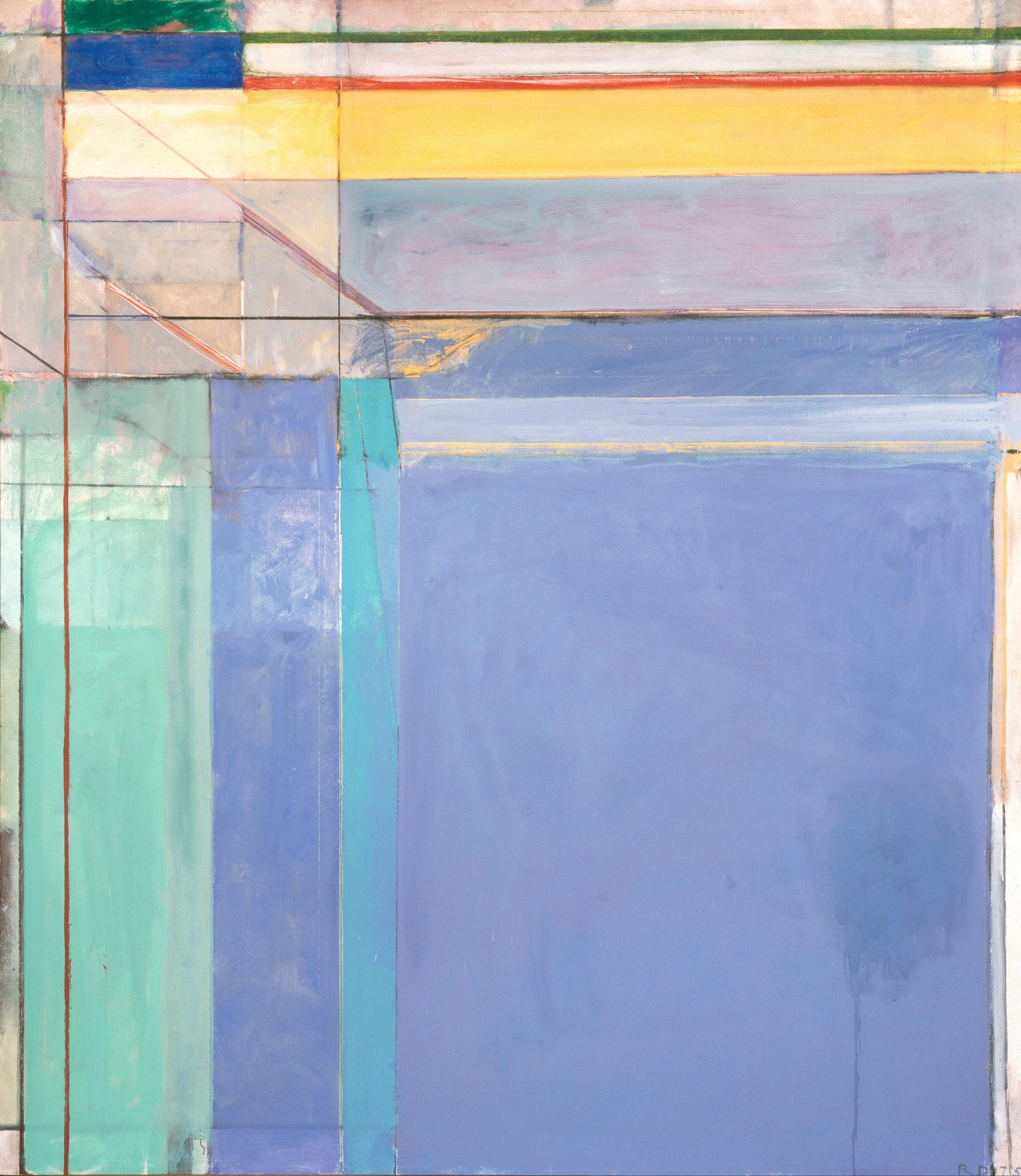
Though best known for his extensive Ocean Park series, those works constitute only one portion of Richard Diebenkorn’s (American, 1922-1993) long career. The artist absorbed a variety of influences early in his artistic life and then forged a unique path between figuration and abstraction over a half century.
In a successful painting everything is integral - all the parts belong to the whole. If you remove an aspect or element you are removing its wholeness. – Richard Diebenkorn

As an art student at Stanford University in the early 1940s, Diebenkorn encountered the work of several established American and European artists. The first whose influence is apparent in his painting is Edward Hopper (1882-1967), the American artist known for his Realist scenes of American life and landscape. Palo Alto Circle was painted during this period and shares Hopper’s interest in ordinary urban buildings with attention to the fall of light through the space. One might be tempted to describe the vivid sunlight on white buildings as typical of Diebenkorn’s California rather than the East Coast areas familiar from Hopper’s paintings, but in works like House By the Railroad (1925) , Hopper captured the summer sun on white buildings in a very similar way. As in Hopper’s work, Diebenkorn has separated the viewer from the building with train tracks and hidden the lowest part of the structure below the level of the tracks. The curtained windows and absence of people is also reminiscent of the earlier artist’s landscapes.
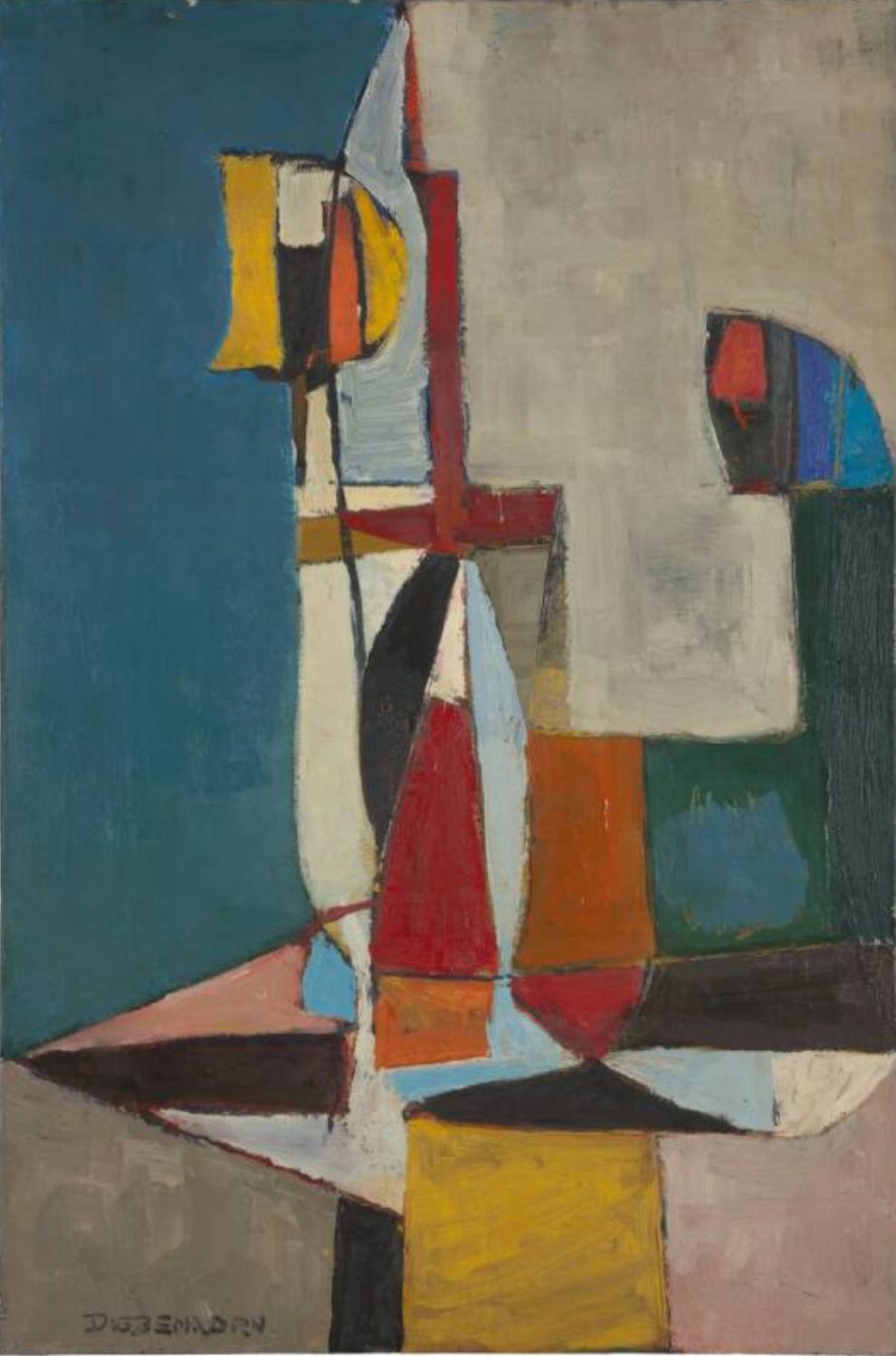
In 1943, Diebenkorn’s education was interrupted by military service during World War II. While serving in the Marines at Quantico, Virginia, the artist was able to visit museums in Washington, New York, and Philadelphia. In this way he continued his artistic education in spite of his service. In New York City, he encountered the artists who would establish Abstract Expressionism as the first internationally influential American artistic movement. In the early 1940s, most were creating works in Surrealist styles. (For more on the Surrealist movement, see Chance Encounters 26 and Chance Encounters 33.) The New York-based artists Arshile Gorky (Armenian-American, 1904-1948) and Robert Motherwell (American, 1915-1991) were especially important to Diebenkorn’s development, with Motherwell becoming a lifelong friend.
Fortunately for Diebenkorn, the war ended before he was deployed overseas and he returned to San Francisco to complete his undergraduate degree and to teach at the California School of Fine Arts (later renamed San Francisco Art Institute). During his time at CSFA, Abstract Expressionism was the dominant style among the faculty. The example above shows one approach Diebenkorn was using at this time. The central elements looks similar to Surrealist automatic drawing and also to some of the forms that appear in Arshile Gorky’s works of the late 30s and early 40s. (For an example see Mechanics of Flying.) The paint application in some areas, especially in the upper right and across the bottom of the composition, shows layering of colors which hints at changes the artist made as the work progressed. This approach, in which under-layers in a different color or tone show through later paint applications, becomes a characteristic of Diebenkorn’s paintings in his later career. It can be seen in Ocean Park #79 above, as well as in many of the works below.
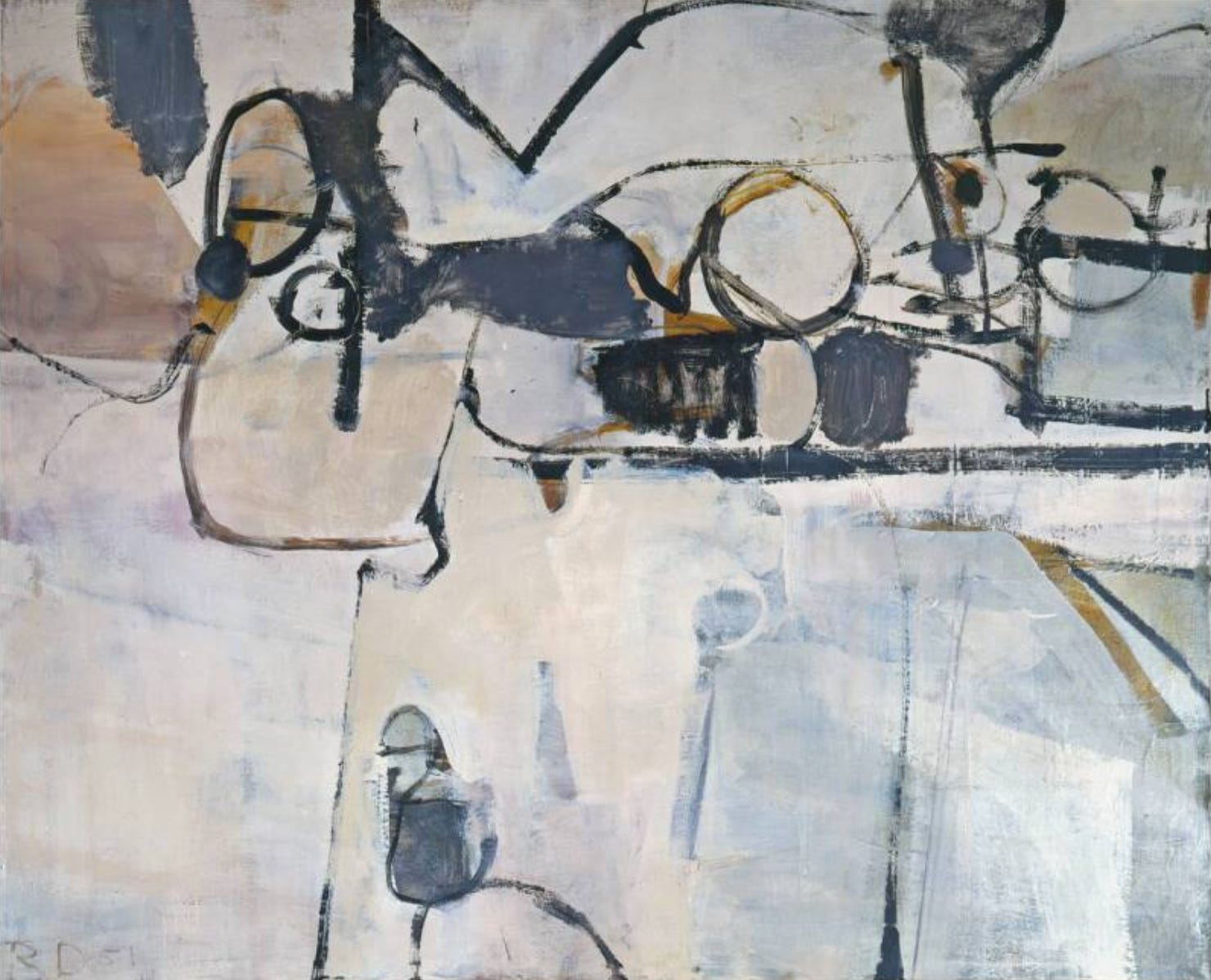
In 1950, Diebenkorn moved with his wife and two young children to Albuquerque, to pursue an MFA using his GI Bill benefits at The University of New Mexico. His paintings of this period continue in the Abstract Expressionist style. The artist continued to use automatic writing elements as well as the layering technique described above. In Albuquerque (1951) from the collection of the Oklahoma City Museum of Art, the artist’s palette is dominated by white and gray with touches of yellow and pink. This palette appears in many works in the Albuquerque series and suggests the semi-desert plateaus and mountains of the area. The calligraphic lines in the upper part of the painting and the variable transparency of the white paint reflects the kind of instinctive, emotional activity that characterizes Abstract Expressionist work by many artists.
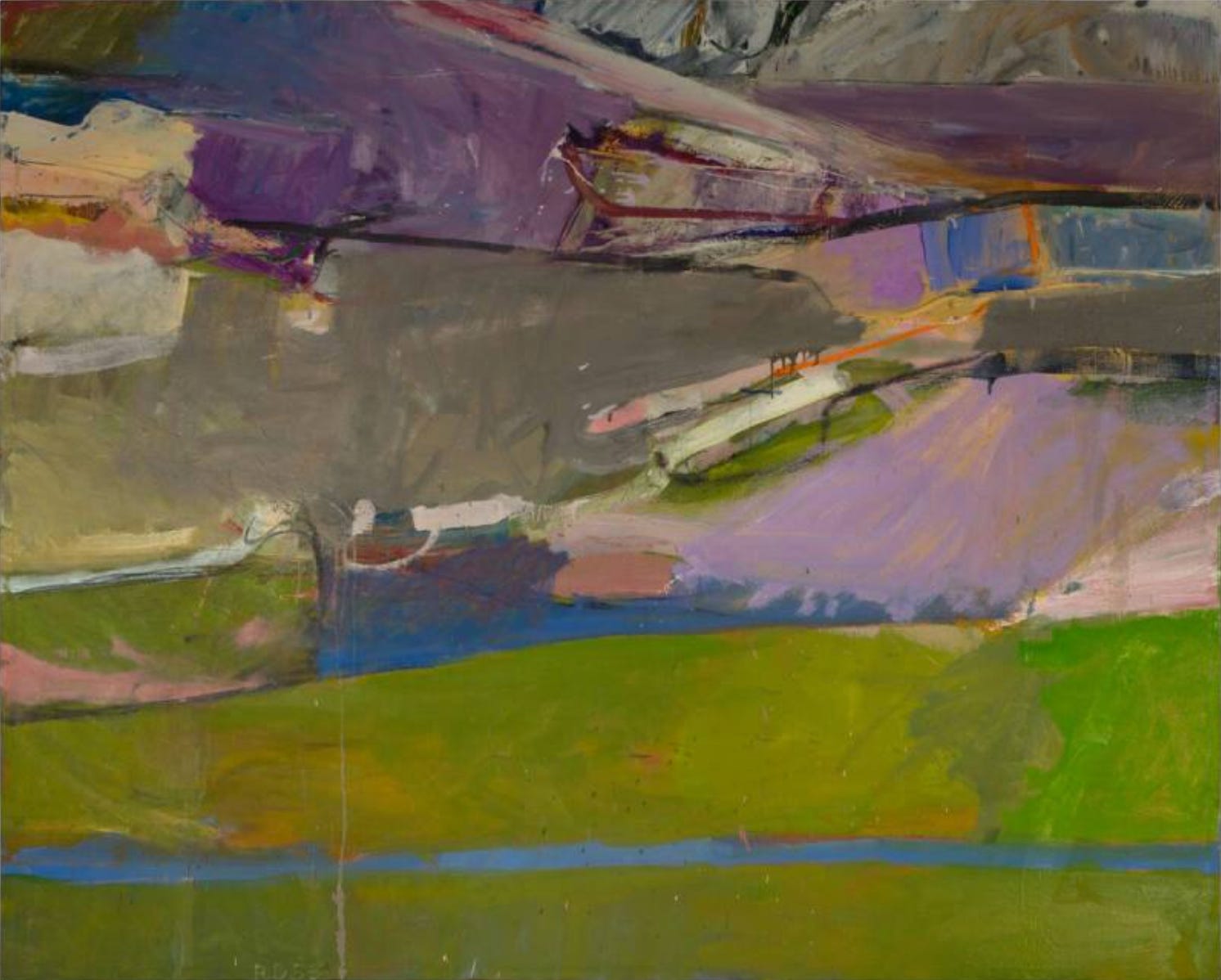
In 1953, having spent a year teaching at the University of Illinois and the summer in New York, Diebenkorn moved his family back to California, settling in Berkeley. The artist taught at the California College of Arts and Crafts from 1955 until 1958, at first continuing in his Abstract Expressionist style, though with a much more varied palette. Having begun numbering his paintings during his time in Albuquerque, Diebenkorn regularly included a number in the titles of abstract paintings he made during this period. Berkeley #56, painted in 1955, shows the more colorful palette the artist was using, doubtless inspired by the very different landscape of his new home. Automatic writing elements gradually disappeared in this period, but Diebenkorn’s characteristic layered paint technique remained; this is most noticeable in the lower third of the composition, in the green strip above the thin blue band. Then in late 1955, Diebenkorn made a major change of subject matter, abandoning the emotional and instinctive abstraction of his Abstract Expressionist works and turning to figurative themes like still life and scenes of the human figure. Later in life, he said,
At one time the common device of using the super emotional to get 'in gear' with a painting used to serve me for access to painting, but I mistrust that now. I think what is more important is a feeling of strength in reserve – tension beneath calm. – Richard Diebenkorn
The quality he describes here is found in this new period when the artist was associated with the Bay Area Figurative Movement as well as in later works like the Ocean Park series.
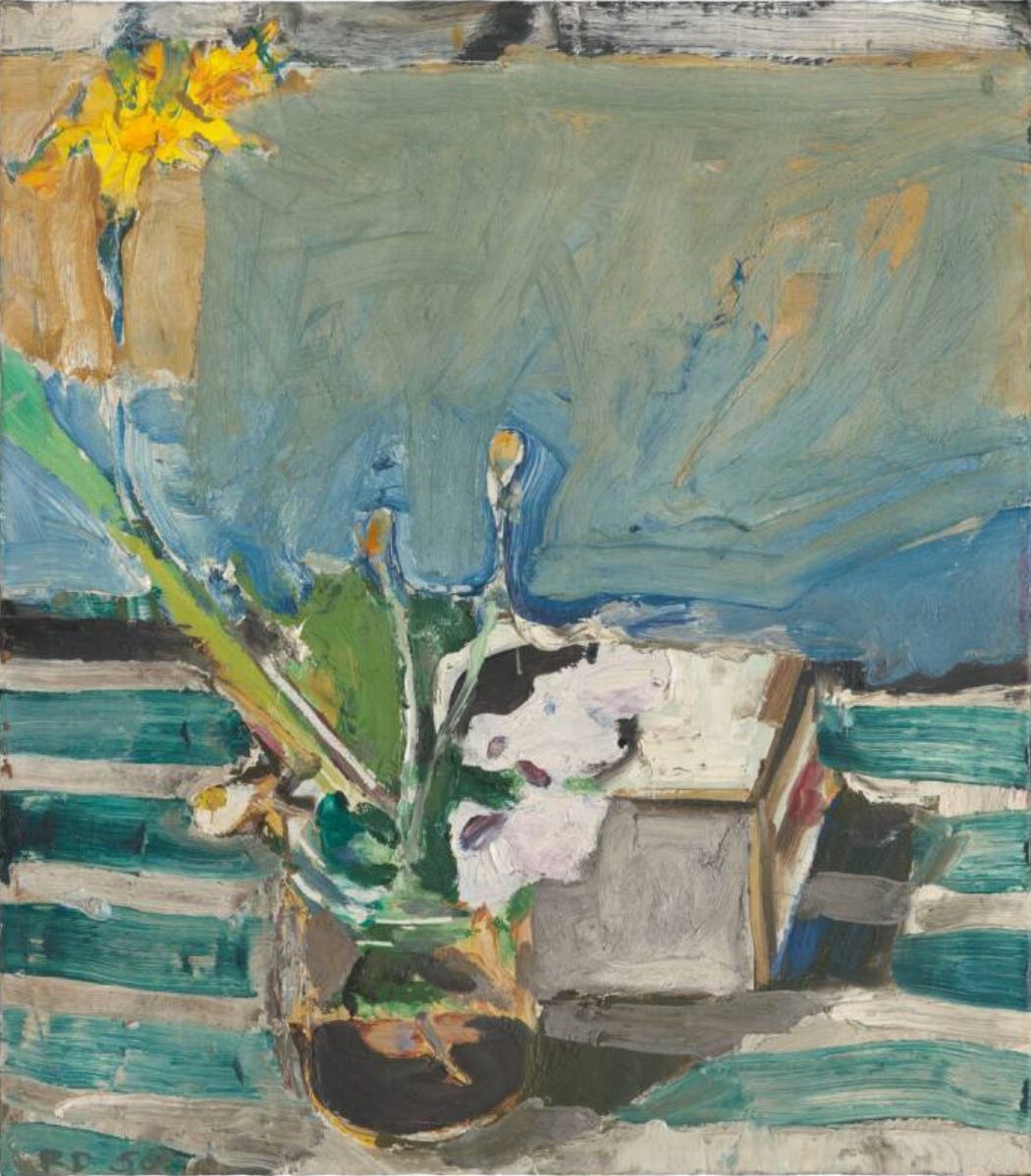
This small still life shows how Diebenkorn took painting techniques from his Abstract Expressionist style and adapted them to his new subject matter. In the background we can see his layered color approach and throughout there is a clear sense of the artist’s hand at work spreading paint and building a composition out of bands and blocks of color.
I have found in my still-life work that I seem to be able to tell what objects are important to me by what tends to stay in the painting as it develops. – Richard Diebenkorn
In Flowers and Cigar Box (1956), we see the artist’s statement play out through the hints of other flowers and leaves that have been painted out or significantly reduced as the artist worked through this composition. At the same time, the thick white of the cigar box appears to have been increased and blended with the pale purple flower beside it to create a point of emphasis.
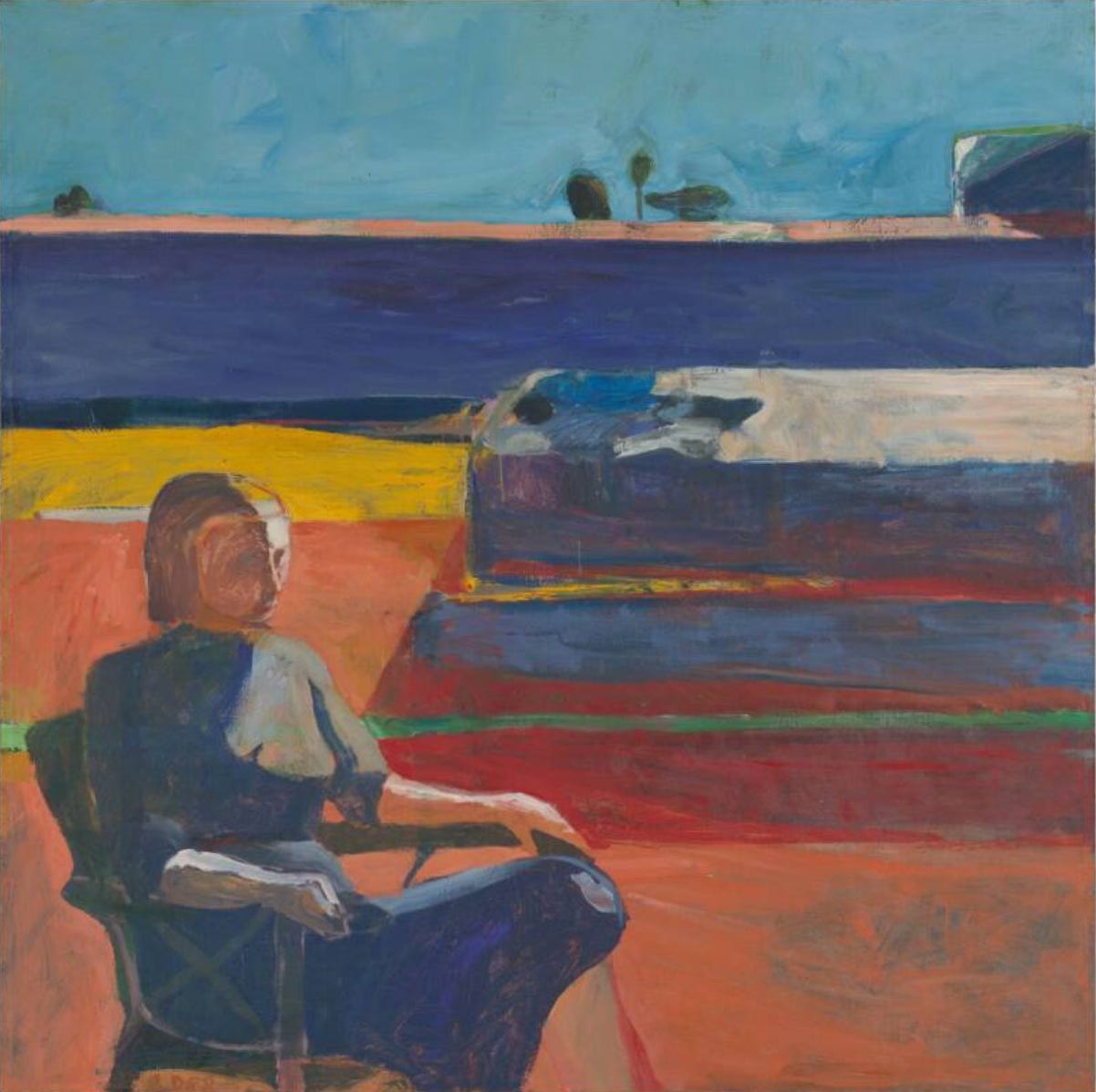
The Bay Area Figurative Movement developed in the mid-1950s in response to the dominance of Abstract Expressionism. Though the latter movement originated in New York, it had spread quickly to the West Coast and many painters in California, especially in the Bay Area had enthusiastically adopted the philosophy and techniques of Abstract Expressionism. Many among the first generation artists of the Bay Area Figurative Movement, including David Park and Elmer Bischoff, had created purely abstract works for some time before switching to figural images. At the time, Diebenkorn was a prominent California Abstract Expressionist who had begun to achieve national recognition. The artist took a risk by making what appeared to be a radical change in his approach. But was the change as radical as it appeared at the time? Diebenkorn’s figurative work maintains the painterly form and layered color of his Abstract Expressionist paintings and his objects are depicted with simplification, that is, still in an abstract style, though not the pure abstraction of his earlier works. Woman on a Porch (1958) is typical of the artist’s figural paintings, a figure embedded in a setting constructed of geometric shapes. Though clearly female, the figure is built from patches of light and color and her facial features are only slightly indicated. Her pose strikes conveys tension, with her hands clutching the chair’s arms and the chair turned slightly toward the viewer. The colorful setting, composed of mostly parallel bands, seems calm at first, but the colors used for the woman and her chair are repeated throughout the setting and the diagonal edge of the red shape ties the woman to the blue wall and the tree top that peeks above it. These interlocking and echoing elements epitomize ideas mentioned in Diebenkorn’s statements shared above; they create a sense of wholeness as well as a feeling of tension beneath calm.
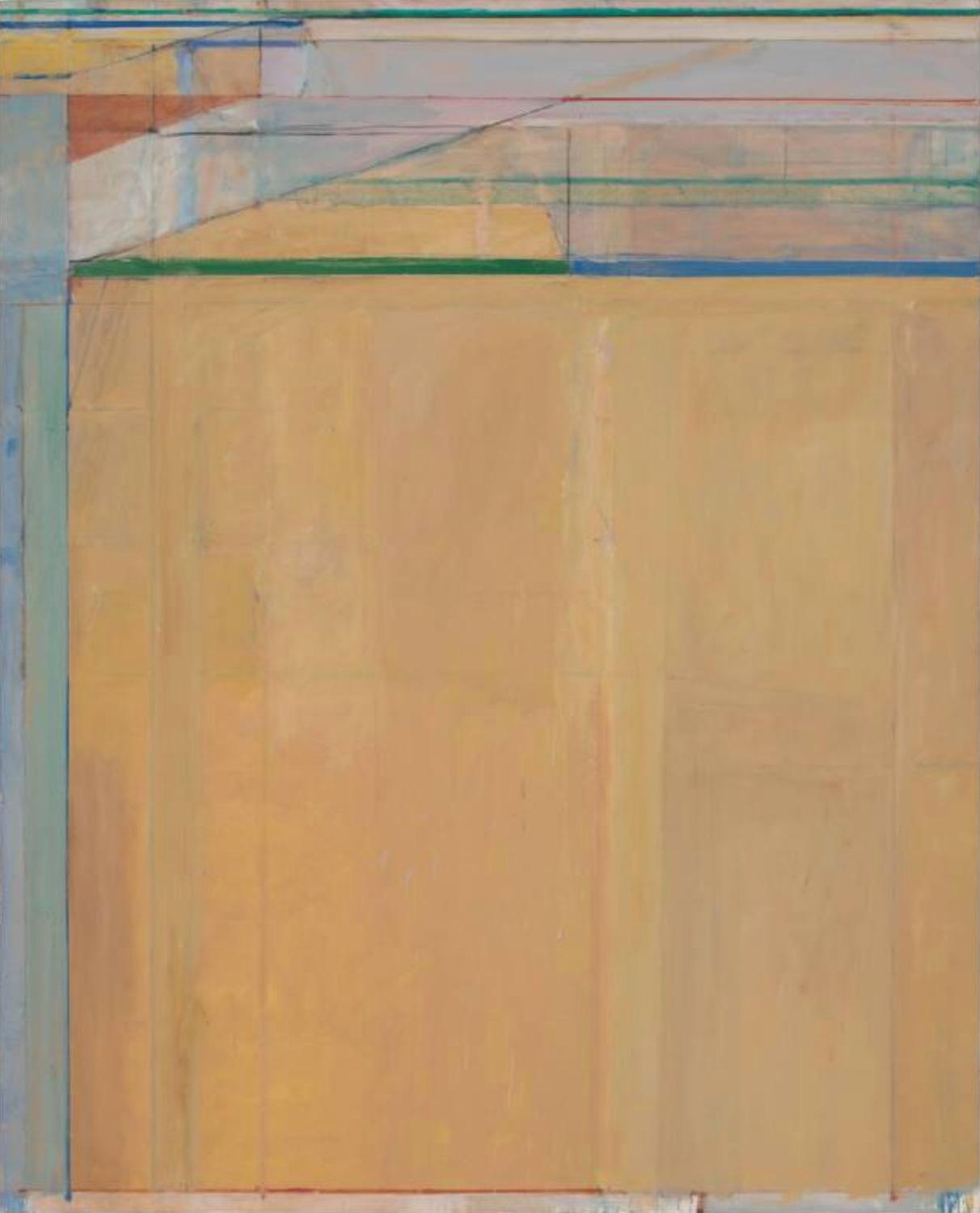
In 1960, Diebenkorn was featured in a mid-career retrospective held at the Pasadena Art Museum (now the Norton Simon Museum) and the California Palace of the Legion of Honor in San Francisco. The artist remained an important member of the Bay Area Figurative Movement and an educator at various colleges and universities in California and Colorado until 1966. During the academic year of 1964-1965, Diebenkorn traveled extensively in Europe, including in Russia on a cultural visa. His experiences would have an impact on his work in coming years, especially having had the opportunity to view important paintings by Henri Matisse (French, 1869-1954) which had long been hidden from Western viewers in Soviet collections. Diebenkorn had first seen works by Matisse in person as an undergraduate student, when he was taken to visit the collection of Sarah Stein, a patron of Matisse and sister-in-law of Gertrude Stein. His interest in the French artist continued throughout his life, reinforced by his trip to Russia and by a 1966 Matisse exhibition in Los Angeles.
In September of 1966, the artist moved to Santa Monica in southern California in order to become a professor at UCLA. That winter Diebenkorn returned to abstraction, beginning the monumental Ocean Park series, which was named after the location of the artist’s studio and which eventually included 140 numbered paintings in addition to drawings, paintings on paper, and unnumbered related paintings. The series, represented in this edition by #67 (1973) and #79 (1975), shows Diebenkorn limiting his artistic vocabulary yet accomplishing an impressive variety of expression.
My freedom will be so much the greater and more meaningful, the more narrowly I limit my field of action and the more I surround myself with obstacles. – Richard Diebenkorn
Two 1914 paintings by Matisse, French Window at Collioure and View of Notre Dame, which Diebenkorn had seen at that 1966 exhibition, are considered by scholars to have been influential in the development of the Ocean Park paintings. Atypical of Matisse’s body of work, these paintings lack the artist’s characteristic lyricism, a result of the onset of World War I, but they suggested new approaches to Diebenkorn. Matisse’s influence is apparent in the repetitive rectangles in the Ocean Park compositions as well as the thin, drawn lines that show through layers of paint in some places and overlay the colors in others. The colors in Diebenkorn’s paintings reflect the southern California landscape outside his studio windows: rooftops, sidewalks, parking lots, beaches, and blue skies. The feature that remains constant, dating back to his earliest abstract works, is the layered color, with semitransparent layers that show traces of earlier colors and geometries. The interaction of the different layers creates the contrast of tension and calm that Diebenkorn was seeking in the later part of his career.
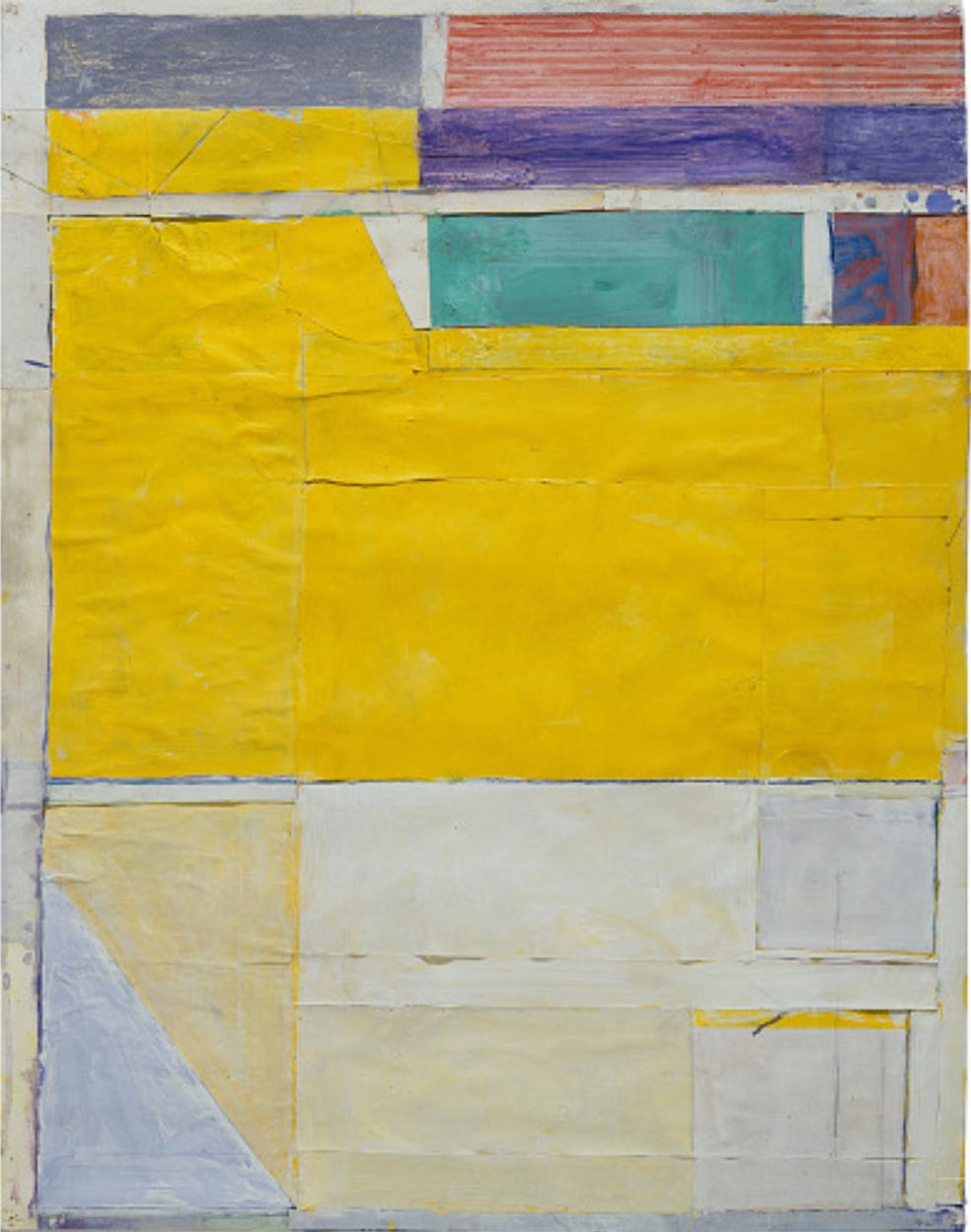
Diebenkorn retired from teaching in 1973; in 1986, he and his wife left southern California, eventually settling and building a new studio in Healdsburg, north of San Francisco. Unfortunately, the artist’s health soon began to deteriorate and it was increasingly difficult for him to execute the large scale oil paintings he’d created for so many years. He continued working in smaller formats — small paintings, drawings and prints. This small work, comprised of acrylic paint, crayon, graphite, and pasted paper mounted on mat board, continues the compositional and color forms of the Ocean Park series on a much smaller scale. It was created the year before the artist’s death, a testament to his continued desire to express himself.
Whether creating pure abstraction or figurative work, Richard Diebenkorn blended the inspiration of his surroundings, his knowledge of art history, and his own artistic sensibilities in endless combinations. His career reminds us that the history of 20th century art extends beyond Paris or New York and that it is possible to forge an important artistic legacy beyond those artistic centers.
An exhibition of Diebenkorn’s figural work is underway, continuing until June 28, 2024, at Van Doren Waxter, 23 East 73rd Street, New York. Exhibition Link




I wish he had stuck with his 1940's visions
I love his use of color. Thank you so much for this interesting look!